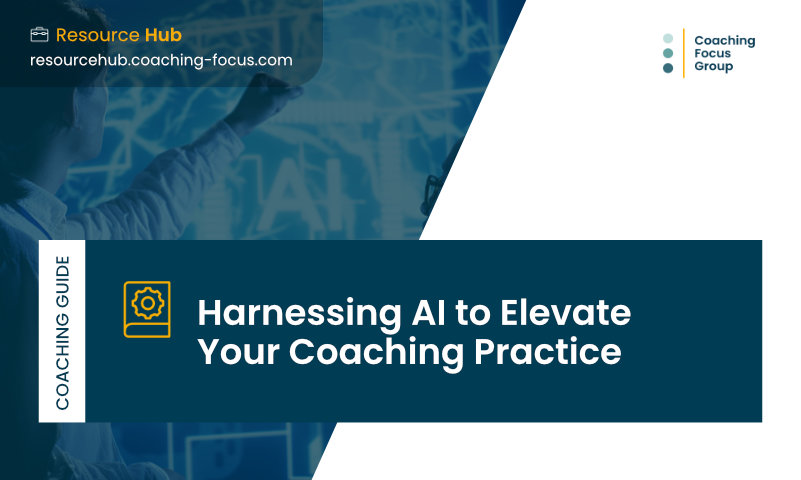Coaching Guide: Harnessing AI to Elevate Your Coaching Practice

Introduction: Coaching Meets Innovation
Artificial Intelligence is transforming how we learn, work, and grow. When woven thoughtfully into coaching, AI can amplify the coach’s impact without replacing the human touch. It’s not about automating empathy; it’s about augmenting insight. This guide reveals how to integrate AI into a formal coaching process, ensuring it strengthens — not dilutes — the human connection at the heart of coaching.
1. Set the Intention
Before introducing AI, clarify why you’re using it. Is your goal to analyse client data more effectively? Personalise learning pathways? Streamline admin tasks? By identifying the purpose, you ensure AI supports your coaching philosophy rather than steering it.
Ask yourself: How can AI free me to do more of what matters — connecting, listening, and guiding?
2. Choose Your Tools Wisely
Select AI platforms that align with your coaching style and ethical standards. Options include:
- AI note-takers to capture and summarise sessions (e.g., Fireflies, Otter)
- Chat-based reflection tools for between-session insights
- Data analytics dashboards to visualise progress and patterns
- AI writing assistants to craft feedback or follow-up summaries
Always review outputs before sharing them. AI should assist, not dictate.
3. Maintain Transparency
Explain to clients how AI fits into the process. Be open about what data is collected, how it’s used, and the limits of AI interpretation. Transparency builds trust and reassures clients that confidentiality remains sacred.
Example: “We use AI tools to support note-taking and identify trends in your progress, but every insight is reviewed by me before it’s shared.”
4. Blend AI Insights with Human Intuition
AI can surface useful data — tone shifts, recurring themes, goal patterns — but only a coach can interpret them in context. Treat AI as a second set of eyes, not a decision-maker. Combine its analytics with your emotional intelligence to deepen understanding.
Tip: Use AI-generated summaries to spot potential discussion points for your next session.
5. Keep the Coaching Relationship Human
AI can’t replace genuine connection. The warmth, curiosity, and empathy of a coach remain irreplaceable. Use AI to enhance preparation and reflection, so your in-session presence stays fully focused on your client.
Golden Rule: If the technology ever starts to feel like a barrier between you and your client, scale it back.
6. Uphold Ethical Standards
Respect privacy, consent, and bias awareness. Ensure AI tools comply with data protection laws such as GDPR. Regularly review outputs for potential bias or inaccuracies. Remember: accountability lies with the coach, not the algorithm.
7. Measure and Reflect
Assess how AI enhances your coaching outcomes. Collect feedback from clients on whether they feel supported or distracted by the technology. Reflect on what’s working, what’s not, and how to refine your approach.
Reflection prompt: How has AI helped you see your clients — and yourself — more clearly?
8. Stay Curious and Adaptive
AI evolves quickly. Stay informed through continuous learning. Attend webinars, join AI-for-coaching communities, and experiment with new tools in low-stakes ways before full integration.
Conclusion: Coaching, Reimagined
When harnessed with care, AI becomes a silent partner — one that amplifies insight, streamlines effort, and unlocks new levels of understanding. The future of coaching isn’t machine-led; it’s coach-enhanced. And with thoughtful use of AI, you can deliver deeper, more personalised transformations while staying true to the art of human connection.
FAQs About Using AI in Coaching
1. Can AI replace the role of a human coach?
No — and it shouldn’t. AI can help with analysis and admin, but the heart of coaching lies in empathy, intuition, and connection. AI supports those qualities; it doesn’t replicate them.
2. What kind of AI tools can coaches use effectively?
Start small and practical. Tools like AI note-takers, chat-based reflection platforms, or data dashboards can help you capture insights, track progress, and save time — as long as you stay in control of interpretation.
3. How can I use AI ethically in my coaching sessions?
Be transparent. Let clients know when AI is involved, what data is used, and how insights are reviewed. Always protect confidentiality and ensure compliance with data laws like GDPR.
4. How do I make sure AI adds value, not distraction, to my sessions?
Use it behind the scenes — for preparation, summaries, or reflection. If the technology starts getting in the way of your connection with the client, it’s a signal to pull back and refocus on the human element.
Summary: Harnessing AI to Elevate Your Coaching Practice
Artificial Intelligence is reshaping the world of coaching — but it’s not here to replace the coach. This guide shows how to weave AI tools thoughtfully into your practice to enhance insight, streamline admin, and strengthen human connection. The key takeaway? When used with care, AI becomes your silent partner, helping you see patterns, free up time, and focus more deeply on what truly matters — your clients.
Ready to take your coaching further?
Discover step-by-step guides, practical tools, and expert resources inside our Coaching Resource Hub — built to help you grow with confidence.
Trayton Vance
Trayton Vance is the Founder and Managing Director of Coaching Focus Group, one of the UK’s leading leadership coaching consultancies. With over two decades of experience, Trayton helps organisations build coaching cultures that unlock potential, drive engagement, and create lasting impact.
Coaching Focus Group
Specialists in leadership coaching, workplace coaching programmes, and building coaching cultures that stick.
[FREE WEBINAR]
Thu, Jan 22, 2026, 12:00 PM (GMT)
.jpg)
You might be interested in...



Employee Engagement Series



.jpg)







